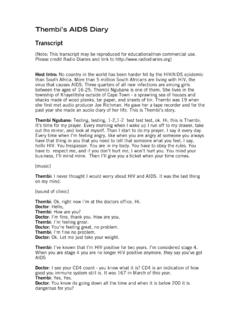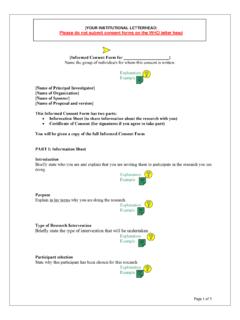Transcription of SAS/STAT 9.2 User's Guide: Introduction to Power …
1 SAS/STAT User's Guide Introduction to Power and Sample Size Analysis (Book Excerpt).. SAS Documentation This document is an individual chapter from SAS/STAT User's Guide. The correct bibliographic citation for the complete manual is as follows: SAS Institute Inc. 2008. SAS/STAT User's Guide. Cary, NC: SAS Institute Inc. Copyright 2008, SAS Institute Inc., Cary, NC, USA. All rights reserved. Produced in the United States of America. For a Web download or e-book: your use of this publication shall be governed by the terms established by the vendor at the time you acquire this publication. Government Restricted Rights Notice: Use, duplication, or disclosure of this software and related documentation by the government is subject to the Agreement with SAS Institute and the restrictions set forth in FAR , Commercial Computer Software-Restricted Rights (June 1987).
2 SAS Institute Inc., SAS Campus Drive, Cary, North Carolina 27513. 1st electronic book, March 2008. 2nd electronic book, February 2009. SAS Publishing provides a complete selection of books and electronic products to help customers use SAS software to its fullest potential. For more information about our e-books, e-learning products, CDs, and hard-copy books, visit the SAS Publishing Web site at or call 1-800-727-3228. SAS and all other SAS Institute Inc. product or service names are registered trademarks or trademarks of SAS Institute Inc. in the USA and other countries. indicates USA registration. Other brand and product names are registered trademarks or trademarks of their respective companies. Chapter 19.
3 Introduction to Power and Sample Size Analysis Contents Overview .. 413. Coverage of Statistical Analyses .. 414. Statistical Background .. 415. Hypothesis Testing, Power , and Confidence Interval Precision .. 415. Standard Hypothesis Tests .. 415. Equivalence and Noninferiority .. 416. Confidence Interval Precision .. 416. Computing Power and Sample Size .. 417. Power and Study Planning .. 418. Components of Study Planning .. 418. Effect Size .. 419. Uncertainty and Sensitivity Analysis .. 419. SAS/STAT Tools for Power and Sample Size Analysis .. 419. Basic Graphs ( Power , GLMPOWER, Power and Sample Size Application) 421. Highly Customized Graphs ( Power , GLMPOWER) .. 423. Formatted Tables (%POWTABLE Macro).
4 424. Narratives and Graphical User Interface ( Power and Sample Size Application) 425. Customized Power Formulas (DATA Step) .. 428. Empirical Power Simulation (DATA Step, SAS/STAT Software) .. 429. References .. 431. Overview Power and sample size analysis optimizes the resource usage and design of a study, improving chances of conclusive results with maximum efficiency. The standard statistical testing paradigm implicitly assumes that Type I errors (mistakenly concluding significance when there is no true ef- fect) are more costly than Type II errors (missing a truly significant result). This may be appropriate for your situation, or the relative costs of the two types of error may be reversed. For example, in screening experiments for drug development, it is often less damaging to carry a few false positives 414 F Chapter 19: Introduction to Power and Sample Size Analysis forward for follow-up testing than to miss potential leads.
5 Power and sample size analysis can help you achieve your desired balance between Type I and Type II errors. With optimal designs and sample sizes, you can improve your chances of detecting effects that might otherwise have been ignored, save money and time, and perhaps minimize risks to subjects. Relevant tools in SAS/STAT software for Power and sample size analysis include the following: the GLMPOWER procedure the Power procedure the Power and Sample Size application the %POWTABLE macro various procedures, statements, and functions in Base SAS and SAS/STAT for developing customized formulas and simulations These tools, discussed in detail in the section SAS/STAT Tools for Power and Sample Size Anal- ysis on page 419, deal exclusively with prospective analysis that is, planning for a future study.
6 This is in contrast to retrospective analysis for a past study, which is not supported by the main tools. Although retrospective analysis is more convenient to perform, it is often uninformative or misleading, especially when Power is computed directly based on observed data. The goals of prospective Power and sample size analysis include the following: determining the sample size required to get a significant result with adequate probability ( Power ). characterizing the Power of a study to detect a meaningful effect computing the probability of achieving the desired precision of a confidence interval, or the sample size required to ensure this probability conducting what-if analyses to assess how sensitive the Power or required sample size is to other factors The phrase Power analysis is used for the remainder of this document as a shorthand to represent any or all of these goals.
7 For more information about the GLMPOWER procedure, see Chapter 41, The GLMPOWER Procedure. For more information about the Power procedure, see Chapter 67, The Power Procedure. For more information about the Power and Sample Size application, see Chapter 68, The Power and Sample Size Application.. Coverage of Statistical Analyses The GLMPOWER procedure covers Power analysis for Type III tests and contrasts of fixed ef- fects in univariate linear models, optionally with covariates. The covariates can be continuous or categorical. Tests and contrasts involving random effects are not supported. The Power procedure covers Power analysis for the following: Statistical Background F 415. t tests, equivalence tests, and confidence intervals for means tests, equivalence tests, and confidence intervals for binomial proportions multiple regression tests of correlation and partial correlation one-way analysis of variance rank tests for comparing two survival curves logistic regression with binary response Wilcoxon Mann-Whitney rank-sum test The Power and Sample Size application covers a large subset of the analyses in the GLMPOWER.
8 And Power procedures. Statistical Background Hypothesis Testing, Power , and Confidence Interval Precision Standard Hypothesis Tests In statistical hypothesis testing, you typically express the belief that some effect exists in a popu- lation by specifying an alternative hypothesis H1 . You state a null hypothesis H0 as the assertion that the effect does not exist and attempt to gather evidence to reject H0 in favor of H1 . Evidence is gathered in the form of sample data, and a statistical test is used to assess H0 . If H0 is rejected but there really is no effect, this is called a Type I error. The probability of a Type I error is usually designated alpha or , and statistical tests are designed to ensure that is suitably small (for example, less than ).
9 If there is an effect in the population but H0 is not rejected in the statistical test, then a Type II. error has been committed. The probability of a Type II error is usually designated beta or . The probability 1 of avoiding a Type II error (that is, correctly rejecting H0 and achieving statistical significance) is called the Power of the test. Most, but not all, of the Power analyses in the GLMPOWER and Power procedures are based on such standard hypothesis tests. 416 F Chapter 19: Introduction to Power and Sample Size Analysis Equivalence and Noninferiority Whereas the standard two-sided hypothesis test for a parameter (such as a mean difference) aims to demonstrate that it is significantly different than a null value 0 : H0 W D 0.
10 H1 W 0. an equivalence test instead aims to demonstrate that it is significantly similar to some value, ex- pressed in terms of a range L ; U around that value: H0 W < L or > U. H1 W L U. Whereas the standard one-sided hypothesis test for (say, the upper one-sided test) aims to demon- strate that it is significantly greater than 0 : H0 W 0. H1 W > 0. a corresponding noninferiority test aims to demonstrate that it is not significantly less than 0 , expressed in terms of a margin > 0: H0 W 0 . H1 W > 0 . Corresponding forms of these hypotheses with the inequalities reversed apply to lower one-sided noninferiority tests (sometimes called nonsuperiority tests). The Power procedure performs Power analyses for equivalence tests for one-sample, paired, and two-sample tests of normal and lognormal mean differences and ratios.
















